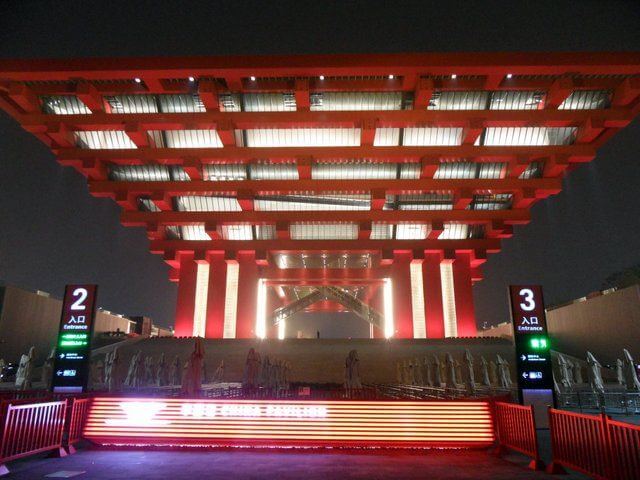
World Expo China Pavilion
The main focus of our trip to Shanghai was to visit the 2010 World Expo. The first World’s Fair was held in 1851 in London, and was intended to showcase innovation and products from all over the world. Since then the focus of the Exposition has changed more towards national pavilions showcasing the best of what each country has to offer in the hope of increasing national branding and therefore trade and tourism. The 2010 Expo is the largest yet, spread out over an area of more than 5 square km and costing anywhere between 45 and 95 billion. Lasting 6 months, with around 400,000 visitors a day, 70-100m people are expected to visit.
192 nations registered for the Expo (three countries that had already confirmed its participation needed to withdraw because of internal problems: Burkina Faso, Bhutan and Kuwait). These are 186 independent countries, recognized by the UN (the home country, China, included); two non UN-recognized nations: Taiwan and Palestine; two associated states of New Zealand: Cook Islands and Niue, and the two Chinese SAR: Hong Kong and Macau. There are also 50 corporate pavilions, mostly from China government departments and NGO’s, but extraneously Coca-Cola and Cisco also got their own showcases.
The pavilions are spread over five zones, on both sides of the river, but really anything of note (i.e. the countries) is on the southwest bank, whilst the corporate pavilions are to the northeast.
[wp_geo_map]The centrepiece of the whole expo is the Chinese pavilion: at 68m high and $220m the largest and most expensive in history, and also the hardest to get into. People queue from 7am, 2 hours before the actual opening time, in the hope of getting a 15 minute time slot. We didn’t arrive until midday, so didn’t even bother trying. Reports in the media suggest queues of up to 6 hours are not uncommon for the most popular pavilions so we opted to just wander round the site and enjoy the impressive architecture of the pavilions. This should have been straightforward enough, but the pushing and shoving of the huge crowds was less than enjoyable, and when it started raining and the umbrellas all came out at my eye height we gave up and found a place to wait it out in the dry.
Strangely you’re allowed to bring food but not drink into the Expo, and having read about the high prices, long queues and lack of decent snacks available we’d brought sandwiches from Subway. Our experience was that there was a wide selection of fresh food from all the major Chinese cuisines and restaurants chains, with minimal queuing. Typically the West was represented by the worst in world cuisine, namely KFC and Burger King, with no sign of decent food from other countries, although we later discovered some of the smaller pavilions such as Sri Lanka were selling some tasty looking nibbles at low prices, but you still needed to queue for an hour or two to get inside.
Some of the smaller countries, such as the Pacific Islands, or Central America were bunched together in large blue warehouse and usuallyconsisted of a collection of cultural artefacts rather than the grandiose displays of other areas. These were easy to get into without much of a queue, but seemed strangely busy, although the Chinese visitors were walking straight through without looking at anything. We later found out a passport system was in operation, with priority passes to the major pavilions being exchanged for collecting stamps at some of the lesser pavilions, in order to spread out the crowds and attempt to lessen the queues. These were also the pavilions at which you are most likely to see an actual representative of the country in question – the little island of Niue had sent two of their entire population of 1400 and seemed genuinely pleased to see an interested overseas visitor.
Elsewhere there was a racket going on whereby people in wheelchairs (and two helpers) are given priority access to pavilions, which is fair enough, but almost every family was renting a wheelchair and demanding that they (and often their 8 relatives) be allowed to bypass the queues. The problem the organisers have is it’s pretty unacceptable to ask someone to prove they’re actually disabled by making them get up and walk around, although you did occasionally see inexperienced wheelchair users stand up and pull the chair up a kerb, or even climbing onto walls to take a better photo.
Accepting that we weren’t going to get inside anywhere on that day we gave up and returned a couple of days later. Tickets are half price if you arrive after 5pm, and a lot of the coach parties seem to leave at about 8, so we’d have a quiet couple of hours before the pavilions all closed. That was the theory anyway, but in reality it was just as busy in the evening, but most people seemed to be heading for the restaurants.
We wandered round pretty much the same route, but looking at the pavilions at night. Some were even more impressive lit up in the darkness such as the Russian and Saudi Arabia pavilions; make to look like a castle and oil tanker respectively, but the drab and angular USA and German pavilions were equally dull by day or night.
It’s going to take a while to get used to the lack of personal space in China. In queues people push themselves tight and flat against your back, to save a little space, even when the queue just isn’t that long. Toilets are plentiful in the Expo site and I found an entirely empty row of 15 urinals. Great, but the next two people in walked all the way to the far end where I was standing and stood either side of me and continued their conversation.
As all the coach parties poured out of the site at 8 we stood on a raised platform and watched the sea of people surge towards the main gates before realising that now would be a good time to get closer to some of the pavilions.
The UK pavilion seemed to be having a power cut, as there were no lights coming from inside or illuminating the queuing area, so people were leaving in droves. We walked in anyway, confident that the combination of British and Chinese staff would get it fixed before we’d managed to get past the rapidly dwindling queue. Rather than the usual 6 hour queue we waited all of 12 minutes before the lights came back on and we entered into what’s been dubbed the Seed Cathedral. It’s a cube made up of 60,000 fibre optics, all containing a different type of seed. These are intended to show how we should try and preserve the world’s plant life – I’m not sure how this is in keeping with the Expo’s theme of ‘Better City, Better Life’ but beautiful and impressive nonetheless.
Saudi Arabia’s pavilion has been called the most interesting inside so we walked the entire length of the Expo ground only to find that the queue had been shut at 6.30 in order to allow the last visitors in by 10.30. The Middle East and Asia pavilions were all very impressive at night and even North Korea and Iran had bothered to put a few lights on theirs.
About ready to leave we passed the Indochina square and dropped into Sri Lanka and Pakistan. By the time we emerged the lights were already out in the rest of the pavilions, so we headed towards the gates. The last pavilion before the gates is the Australia pavilion, still with Aussies outside and letting people in. They were the last pavilion open on the night and kept shouting how they were the hardest working pavilion in the show. The pavilion itself is made of weathered steel, left to oxidise and turn a deep ochre colour, reminiscent of Uluru, or Ayer’s Rock as it used to be known.
Inside a large spiral path shows you the history of Australia, and its relationship with China, their largest trading partner. Further up the three storey building is an overview of the natural beauty of Australia and a single panel on Women’s Rights which looks like an afterthought. At the top you’re led into the centrepiece, a large 360 degree auditorium where you’re shown an animated video on a cylindrical screen whilst the stage in the centre gets redressed. The high quality animation features a Chinese girl and Australian boy musing on the joys of leaving the country behind and moving to the big city, which whilst in keeping with the festival seems at odds with the earlier exhibits of the Outback.
The base of the Australian pavilion has a small food concession selling traditional Aussie fare, which appears to be mostly beer with the occasional BBQ’d chicken burger, so fair enough.
We emerged from the Australian Pavilion to find the rest of the park had pretty much shut for the night, but the Aussie crew were just getting started and a great live band played into the night and we left the park with a fun rendition of Men at Work’s Down Under, complete with flute solo, accompanying us into the night.






Pingback: Virtual Crowds